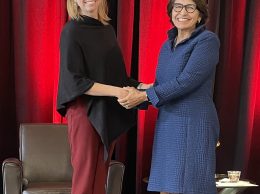Our view: Grant will help museum create sustainable future
Ventura County has taken a big step toward creating a living legacy for future generations with interim funding to bolster the Museum of Ventura County.
A $125,000 grant was approved by the Board of Supervisors in a 4-1 vote on July 25, paving the way for the city of Ventura and private donors to step up to support an institution that contains much of the cultural legacy of the county.
The museum has tremendous assets — an attractive facility in downtown Ventura, an agricultural museum in Santa Paula, and countless artifacts that have been donated over the years. It welcomes thousands of visitors, including plenty of school kids, during the course of a year.
But the museum badly needs trained volunteers to sift through and catalogue its collections. It needs to digitize at least the catalog of its photography collection and bring that collection up to date.
And it needs to find ways to collaborate with other organizations, notably CSU Channel Islands and California Lutheran University, whose students could provide much-needed support for cataloging and research activities.
With funding to sustain the museum through a lean patch, interim director Elena Brokaw will gain time to begin putting together a longer-term vision for the museum. Fortunately, the Ventura County Community Foundation, which went through its own restructuring about a year ago, is now on firmer financial footing, with increased capacity to work in partnership with the museum on its turnaround plan.
Building cultural institutions is not easy work; it takes time, dedicated volunteers and donors and a willingness by community and business leaders to think about a cultural legacy.
Eventually, the Museum of Ventura County will need to develop and market new memberships, build a much bigger donor base, gain some long-term grant funding, and create an endowment in order to keep operating without returning to public sources for funding over and over again.
Keeping the doors open is the first step. The next steps for the museum must lead to a more sustainable future.
BROWN EXTENDS CAP-AND-TRADE
Capping a victory marked by bipartisanship and a belief that market-based solutions will work, Gov. Jerry Brown on July 25 signed a bill extending California’s first in the nation cap-and-trade system for curbing greenhouse gas emissions.
The cap-and-trade program was created by legislation in 2006 and was signed into law by Gov. Arnold Schwarzenegger.
Brown’s signature fulfills his pledge that the state will continue to innovate on climate issues even while the Trump administration pulls back from a global effort to curb global warming.
Cap-and-trade is complicated to administer, but the beauty of the system is that it allows a wide range of companies to keep on operating — as long as they pay for permits to mitigate their carbon emissions. It has been proven to work any number of times, notably in the global reduction of acid rain in the 1990s.
That’s a far better solution than a command and control system that forces companies out of business and drives away middle class jobs.











